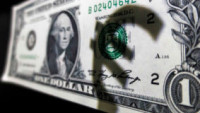 Equity markets slid back yesterday as the decline in oil prices which started on Monday continued into Tuesday, while a downbeat assessment of the Japanese economy helped to sour sentiment further.
Equity markets slid back yesterday as the decline in oil prices which started on Monday continued into Tuesday, while a downbeat assessment of the Japanese economy helped to sour sentiment further.
Any hope that the US economy would show renewed signs of a pickup in consumer spending also came to nothing, despite a slightly better than expected February retail sales reading of -0.1%. A closer inspection of the numbers showed that the January number was revised lower by 0.6%, coming in at -0.4%, down from a 0.2% gain.
On the plus side the latest Empire manufacturing survey returned to positive territory for the first time since July last year, while late last night oil prices managed to rebound a little after the latest API inventory data showed a much smaller build than had been expected.
Given that stocks have been trading near to multi week highs this continued mixed picture not unreasonably had the more prudent players in the markets pare back some of their recent exposure ahead of the conclusion to today’s Federal Reserve rate meeting, though today’s oil rebound looks set to see a slightly higher open this morning.
Before today’s FOMC meeting we have the small matter of the latest UK unemployment and wages data, as well as the UK budget, with the pound coming under renewed pressure yesterday on the back of a survey which showed that the Brexit “leave” campaign was slightly ahead in the polls.
While some of the most recent UK data has been a little disappointing in recent weeks, the unemployment data has been one of the main bright spots.
Despite recent negative headlines about job losses in the manufacturing sector there hasn’t as yet been any evidence of this being reflected in the unemployment data, though that could well change in the near term. Expectations are for the January ILO unemployment rate to come in unchanged at 5.1%, while average earnings are expected to show a rise of 2%, still well above the rate of inflation.
Most attention will be on this afternoon’s budget speech by UK Chancellor George Osborne, where he will have to navigate a tricky path in looking to keep his current spending plans on track, while not antagonising too many voters ahead of the June referendum vote.
Ultimately it is likely to be an exercise in obfuscation as the Chancellor tries to navigate the nation’s finances around a slowing global economy, as well as a slightly uncertain UK economy, a task not helped by his own governments over dramatic tactics with respect to swaying wavering voters about the risks of voting to leave the EU.
In talking down the UK’s economic prospects in recent weeks the government has made its task of boosting the economy, and thus future tax revenue that much harder. In so doing they have made it much more likely that UK rates will stay lower for longer, and while that is likely to keep debt interest payments lower, it won’t make it any easier to meet his fiscal targets for a budget surplus by 2019.
Amongst some of the flagged measures we could see some tax rises on insurance premiums, fuel duty and spirits, which could be offset by some increases in personal allowances, and higher rate tax thresholds. We could also see some measures to help North Sea oil firms as they battle the effects of low oil prices.
We round off the day with the latest Fed decision on rates, and while no change is expected, all eyes will be on Fed policymakers expectations for future rate rises.
Will they revise their dot plot projections lower given recent market volatility?
Is there concern about the strength of wages after last month’s 0.1% decline?
More importantly how do they see the US economy in light of recent global events and local economic data, and given the political circus surrounding the upcoming Presidential election is there a chance that could influence the Feds stance towards the economy and potential rate path.
The latest CPI inflation numbers for February are expected to show a 0.2% decline on the month, with year on year, including food and energy falling back to 0.9% from 1.4%. Core prices are expected to remain steady at 2.2%.
EURUSD – after the rally to just above the 1.1200 level last week we’ve started to slip back towards the 200 day MA at 1.1050. This needs to hold for a move towards 1.1380 and the February highs to unfold. Only below 1.1030 argues for a move towards 1.0800, with a break targeting 1.0600.
GBPUSD – the pound has continued to slip back after last week’s highs above 1.4400, which means that in the short term we could well see a pullback towards the 1.4120 area. While we stay above this key level and last week’s low, we could well see further gains towards the 1.4600 area, however a fall below 1.4080 could see a return towards 1.3800.
EURGBP – last week’s low looks like a potential neckline support between 0.7670 and 0.7690. With resistance currently at 0.7860, a failure to break higher could trigger a fall towards that support and potentially a move to 0.7520. A move above 0.7860, could well revisit the 0.7930 area.
USDJPY – still side-lined between support at 111.00 and resistance at 114.90 we need to see a break one way or the other for clues as to the next move. The bias remains towards the downside towards 106.00 while resistance at 114.80 remains intact. Above 115.00 argues a short term base is in place.
Other useful information for traders:
- Forex Forecasts & Analysis
- Forex Brokers Reviews
- Rating Forex Brokers
- FxPro Reviews













